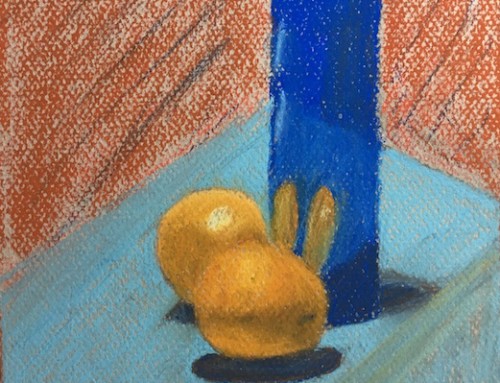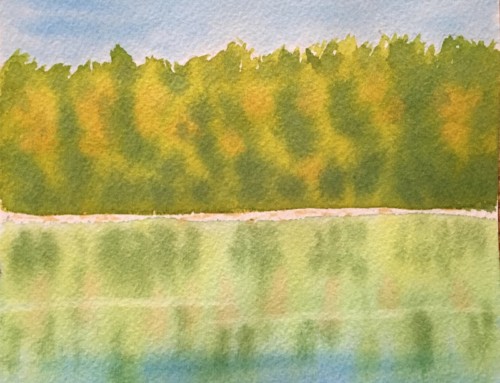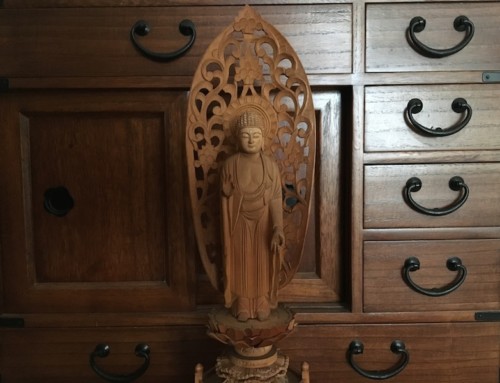A couple of weeks ago I brought a student to this zendo for the first time. At the end of the evening she said: “Next time will be better; I’ll know what to do.”
And I said: NO NO NO NO NO – the mind that you came here with tonight is the one you want to keep, that beginner’s mind. When we don’t know we can’t be other than in the present. When I first went up to the mountain monastery and did the morning chanting service, and the sutra book was put in front of me, and I chanted those chants, syllable, by syllable by syllable, it was really hard to pay attention. I never paid attention in my life to what was in front of me. But with those chants I was forced to be in the moment. Those chants were something that helped me to do that. Now that I know them, a lot of them by heart, it’s so much easier to space out.
Shunryu Suzuki, in “Zen Mind, Beginner’s Mind,” says: “The goal of practice is always to keep our beginner’s mind… In the beginner’s mind there is no thought, ‘I have attained something.’ All self-centered thoughts limit our vast mind. When we have no thought of achievement, no thought of self, we are true beginners. Then we can really learn something… If you start to practice zazen, you will begin to appreciate your beginner’s mind.”
No matter how many times I read this and no matter how many times I remind myself of this, I always hear it in a new way. “…. It is the secret of Zen practice.”
When I was thinking about this talk and what I would say regarding “I Don’t Know,” I knew I’d have to say something, I’d have to “know” something. So I started taking all these books down from my shelf. What can I talk about? I have to find something about not knowing. I opened “The Zen Teaching of Bodhidharma” and randomly selected a passage:
“If you use your mind to study reality, you won’t understand either your mind or reality. If you study reality without using your mind, you’ll understand both. Those who don’t understand, don’t understand understanding. And those who understand, understand not understanding. People capable of true vision know that the mind is empty. They transcend both understanding and not understanding. The absence of both understanding and not understanding is true understanding.”
Well! I was totally confused by this. I thought, oh my God, I don’t know anything. But how do I convey this? How do I convey… And maybe you all understood that.
I’ll bet that if I read that again and we all just sat and listened with our bodies… there would arise a pure understanding of what all that means. But I always try to ‘get it’ from my brain and so I have to keep sitting.
Some Zen masters say that it takes 30 years of sitting on a cushion to gain some glimmer of understanding. I’ve only been sitting for about 20 so I’ve got a long way to go. When I met my first monk, Donge, he told me to put down the books. And just sit.
So what is it that we do on the cushion, to not know? I can only tell you about my experience, and what it’s been for me has been a sit by sit dismantling of my habituated, conditioned patterns of thinking, of acting, of being.
By sitting, or PAYING ATTENTION, our patterns break up and we become, again, open to the mystery of being. It’s not always easy and it’s not always fun, but it’s always worthwhile, even when I go crying to Roshi seeking answers and all he says is: “sit more” or “suffer more” or “expect nothing.” And I return to my cushion deflated or inflated or frustrated or energized. This bringing attention to what arises as I sit brings me to some clarity, to the middle way, to some minute understanding of who I am.
Recently when I went into Dokusan, I was caught in the trap of my mind, and just suffering with a koan, and I wanted him to tell me, to give me something. So he just said: “Suffer more!” and I thought he was so uncompassionate.
By the end of sesshin I understood some of what Roshi meant by “suffer more” and today I found this quote by Carl Jung that shed a little more light on that for me: “Compassion is the sacred space that in which an individual can suffer the suffering he needs to experience.”
So, I’m beginning to understand some of that, some of what Roshi means when he says: “Suffer more!” It’s a relief really not to have to know something more than what I know right now.
One of my favorite Zen masters, Yogi Berra, said a couple of things that are very Zen like, one of which caught my attention today:
“You can see a lot just by looking.”
Another one is: “Nothing is like it seems, but everything is exactly like it is.”
And Michelangelo, when asked how he sculpted David said that he “chipped away everything that wasn’t David.”
This is what zazen practice is. Chipping away at everything that isn’t us. All the false knowing.
So, from the experience of sitting on the cushion we begin to understand in our bones that we are not separate from what we experience. It’s that feeling separate from what we experience that causes us so much suffering.
There is a phrase from a James Joyce story that describes what I was like for most of my life—for a lot of my life, before I found the cushion: “Mr. Duffy lived at a little distance from his body… regarding his own acts with doubtful side-glances.”
I was always living outside of myself, separate from myself.
Buddha said right before he died: “Be a Lamp unto yourself.”
On the one hand I don’t want anyone to tell me what’s what, what the truth of life is, to explain the mystery of life to me. On the other hand I want answers and think that a Zen monk or someone else will give them to me. Throughout my life I was looking for answers/for the solution/for love/for enlightenment in all the wrong places. When I finally found Buddhism I felt that the answers were here.
When I sat down on that cushion for the first time, I was in so much mental agony from a failed relationship. I had lost at love once again. I thought I wasn’t lovable, couldn’t love, and I just went to the monastery in a state of desperation. My father had died three years before. I was a shell of a person, really. And my mind wouldn’t stop. I was told to sit down on the cushion, they had showed me some positions, and they rang the bell, and we sat for forty-five minutes.
I thought I was going to die. Everything went through my head. I can’t, oh my god, I hate this, what am I doing here. I didn’t know anybody. I didn’t know… but I was so wrapped up in the pain of my body that all that noise in my head went away for a little while. And then I got up, and even though it was so painful, I knew that there was something there. There was something in that act of sitting still on that little black cushion and I didn’t know what it was. But I felt it in my bones, I felt it in my body that there was something there.
Suzuki says: “The purpose of studying Buddhism is not to study Buddhism, but to study ourselves. It is impossible to study ourselves without some teaching… But the teaching is not we ourselves; it is some explanation of ourselves. So if you are attached to the teaching, or to the teacher, that is a big mistake. The moment you meet a teacher, you should leave the teacher, and you should be independent. You need a teacher so that you can become independent. If you are not attached to him, the teacher will show you the way to yourself. You have a teacher for yourself, not for the teacher.”
So, Study Yourself. And the way we do that of course is through zazen.
Even after 20 years, I did not leave my teacher once I found him, I still go to him hoping that he will illuminate my confusion. (I have since left this teacher, but that is another story, another day, another blog.)
I keep thinking that there’s some kind of secret, that all the monks know the secret. They’ve got the secret to koan practice. Now, I don’t want to become a monk, but I’m going to find out what that secret is; in figuring out those goddarn koans. But even Buddha said: “There is no secret teaching. There is no hidden meaning.” But I still look.
Again, Yogi Berra: “In theory there is no difference between theory and practice. In practice there is.” I’ll say that again. “In theory there is no difference between theory and practice. In practice there is.”
What I was looking for (and sometimes still do, when I’m away from the cushion too long) is some kind of certainty, something permanent and unchangeable. Even when I was a child in search of God. I wanted something tangible, something to hold on to. But the first thing we learn in Buddhism, the first truth is that of impermanence. Everything changes. People die. I’m going to die! But no one can tell me what that might feel like.
A student approached a Zen Master and asked, “What happens after we die?”
The Zen Master said, “I don’t know.”
“You don’t know?” exclaimed the student. “But you are a master!”
“That may be true,” was the reply, “but I’m not a dead one.”
So, how do we understand death until we die? We talk in Zen a lot about dying on the cushion. Die on the cushion! I’m not even going to tell you what that means. Most of you in this room know what that means.
Thich Nhat Hanh says: “Practice every day. It will save your life.”
And truly, without question, and I say this all the time: this practice saved my life.
I want to read this thing from Arthur Miller, who recently died. It’s from “After the Fall.” “…… I think one must finally take one’s life in one’s arms.”
And I think that’s what we do. I don’t know if Arthur Miller was a Zen practitioner or not, but when I read this it felt like that’s what I did when I sat on the cushion. That’s what I feel like I do every time I sit on the cushion. I don’t know, I really don’t know. It’s a mystery to me. And I’m happy to have it still be a mystery, to have life be a mystery. That opens up so much, so much life.
Two weeks ago Daiden gave a Dharma talk and he talked about some Greek guys, Diogenes being one of them, so I had to get a quote from a Greek here. This is from Sophocles:
“It is a painful thing to look at your own trouble and know that you yourself and no one else made it.”
All I can say is: I Don’t Know. Thank you.






Leave A Comment